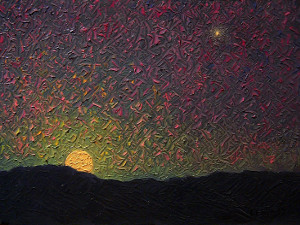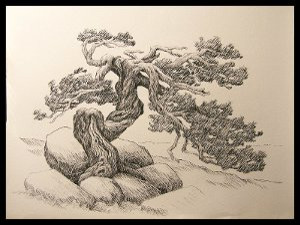A
Poignant Story...
"Scarred for life in the fire of an old
southern plantation, and stumbling into the care of impressionist
master, Birger Sandzen... this is the story of E. E. Glass. A story of
resurrection and redemption, of the unconditional love of two women and
a life's calling to unappreciated creativity"
Emerson
Everett Glass was
born in poverty and died in poverty, having never sold a
painting. Glass's father was a foreman on a cotton plantation
in the deep south, near the town of Clinton, Louisiana. At
the age of seven, a fire destroyed the boy's home and his father and
mother died in the blaze. Emerson himself was badly burned
and scarred for life on the left side of his face and upper body...
leaving him scarred in more ways than one.
A plantation worker took the young boy in and cared for him till he
left home at the age of 23. "Mammi Jax" was a black woman,
born and raised as a plantation slave and served as cook for the master
of the plantation. The deformed Emerson Glass was worth
little more than an object of abuse in southern society, even for a
white boy... but to Mammi Jax, he was the son she never had, and always
spoke to the boy as if he was the Prince of Baton Rouge, destined for
greatness. To the rest of the world, a boy with no education,
no social acceptance and no hope for the future... EE Glass was a
castaway.
When Glass was 13, the great depression hit this country like those
freight trains that roared through Clinton but never stopped.
Nonetheless, despite the lack of education, Emerson found ways to make
his own colors... from red clays and roots and berries, to rocks and
bits of cloth ground into pigments, Glass rubbed his rudimentary
pigments together and stored them in jars, spreading them onto
cardboard panels with twigs and branches. He would
get off by himself for days at a time, spreading his handmade colors on
bits of cardboard and shirt stuffers he was given from grocery stores
and laundry services. He knew nothing of government help for
artists during the years of FDR and the WPA. He simply worked
alone in fields, far from civilization and the pain of exposure to
society.
Prior to the death of Mammi Jax, Glass had never seen a real painting,
met an artist or been to a museum. He was 23. Yet
in Montgomery, Alabama, Emerson Glass found his first exposure... a
show of the great impressionists at the Museum of Fine
Art. He wept in delight at the sight of the great
masters... Renoir, Monet, Pissarro and others of the early modernist
movements. Color just for the sake of color became a new
source of passion for Glass. He took jobs washing dishes and
sweeping floors so he could buy colors he had never seen
before. Slowly but surely, he grew in skill and determination
to paint.
Emerson Glass met Birger Sandzen in Lindsborg, Kansas during a brief
stopover when he was around 30 years old. By invitation, he
stayed briefly to study with the artist before continuing
west. Glass did not attend Bethany College, but found a
compassionate and understanding friend in the older artist.
Emerson always spoke of Sandzen in the most affectionate of terms, as
he was one of the few people who ever treated him with dignity and
respect. Sandzen's influence on him went deep, far beyond the
teaching of artistic techniques and methods. This influence
is quite evident in his work, despite the fact that Glass had a
demanding eye for detail and was a careful draftsman. From
the day they met, Emerson Glass and Birger Sandzen were linked together
in vision and purpose.
It is known that he met William H. Walker, presumably in Kansas
City. Walker described him as an "innovative post-runner of
the American impressionists". The influence of other artists
can be found only by conjecture to associate with the work of EE
Glass. Because of his awkward appearance, he avoided public
exposure and would not engage in social events so necessary for
emerging artists of his day. Without galleries or patrons, EE
Glass was destined for obscurity for the rest of his life.
In 1954, Emerson met Nina Brandt. The couple seemed like a
perfect if not serendipitous match, for she was blind and he was
deformed. Under common law marriage, they lived together for
the remainder of Emerson's life, when he died after a lingering
respiratory illness at the age of 71 in a tiny apartment in a rural
area south of Kansas City, Missouri. What Nina did for
Emerson was support his desire to see what she couldn't... the wide
horizons of the great midwest, from the abundant wildlife and fields of
grain to the majesty of the Rocky Mountains. There is no
evidence that they ever traveled east of the Mississippi River.
Nina was able to obtain government disability support, most of which
was used for painting materials and travel expenses for she and her
husband. In return, Emerson taught her to read Braille...
this despite the fact that he was a poor reader. Yet in his
own words, he could "feel the language with her", and they both learned
from books without print.
Among his artworks, there was found a curious print from Birger Sandzen
that Glass had colored in watercolor. It was signed by both
artists and carried a label from Old Estes, a gallery in Estes Park,
Colorado. There is no record of Emerson Glass ever exhibiting
his work there and, as far as is known, he never sold a
painting. The fact that he and Nina lived in the barest of
circumstances was never a hindrance to their happiness together, and
their privacy and seclusion was just what they liked.
The bulk of E. E. Glass paintings extant were executed between 1965 and
1985, which was the most active period for the artist. The
very early works are essentially non-existent. Works prior to
1940 were done with such poor materials and were of such relatively
poor quality, that they have deteriorated beyond usefulness.
When Glass began to use better materials, his learning curve and
progress as an artist was slower, and he didn't begin show his mature
style until the mid 60's. The finest work and the boldest
color is found in the artist's paintings done between circa 1967 and
1978. He kept no journal or records, so these dates are all
approximate, taken from lengthy discussions with Nina Glass.
POST NOTE: Nina Glass died in March, 2007. Two
years prior to her death, and having no children or other relatives,
she entrusted the estate of her husband's work to her executors and G.
B. Tate & Sons of Laramie, Wyoming. Mrs. Glass was a
grand lady who's quiet manner spoke of an elegance that belied her
circumstances. It was agreed not to offer or display her late
husband's work until after her own death... for she could not stand the
thought of any further rejection of her late husband or his
work. This was an absurd notion, seeing the exceptional
quality of Emerson's work, and yet the agreement has been honored to
the letter.
************************
Emerson Everett
Glass (American, 1916 - 1987)
Born near Clinton, Louisiana -
Died near Kansas City, Missouri
Painter in oils - Impressionist
landscapes Influenced by the European Impressionists
Had a continuing
close relationship with Birger Sandzen
Worked in Kansas, Nebraska, Colorado,
Wyoming, Montana and into California
Biographical information
obtained from Nina Glass, artist's widow
Written by Gayle B. Tate,
owner of G. B. Tate & Sons Fine Art, Laramie, Wyoming
|

